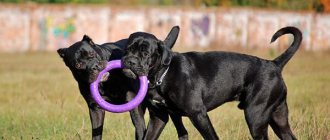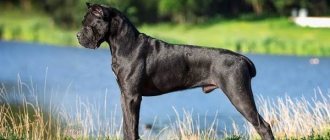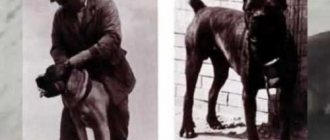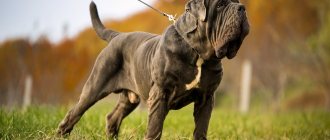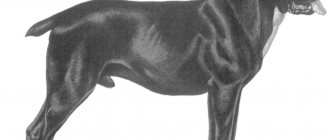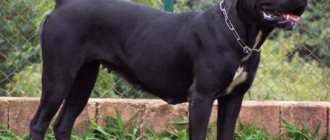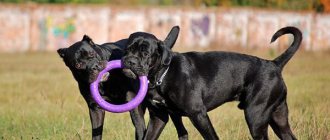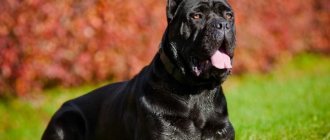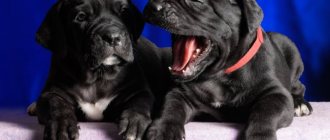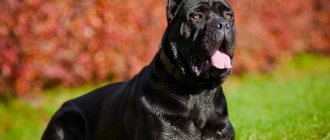Description of the Mastino Neapolitan breed
Popularity 68th place among 263 dog breeds
Lifespan:
9-11 years
Breed group:
Sentinels
Height:
males: 65-75 cm, females: 60-68 cm
Country of origin:
Italy
Average price:
25 thousand rubles
Weight:
males: 60-70 kg, females: 50-60 kg
Latest articles Cat health
Rabies vaccination for cats: choice of vaccine, necessity, schedule 01/22/2022 15 0 0
Selection and adaptation
TOP 20 best cat breeds for families with children 01/22/2022 27 0 0
Vices and shortcomings
Since the price of the French Mastiff is quite high, you need to carefully study the breed standard before purchasing it. Especially when it comes to purchasing a dog for exhibitions. This document clearly states all the shortcomings and vices that do not allow the dog to participate in breeding.
The official standard does not allow a short round head with prominent eyes, lateral deviation of the lower jaw, arched back and flat hips. Serious faults include turned-out front legs, close or barrel-shaped hind legs, short wheezing, and too much or too little stifle angle.
The French Mastiff should not have a long, narrow head with poor compression, a Roman nose and a twisted jaw. Animals with atrophied, curled, knotted or horizontally deflected tails are not allowed to participate in exhibitions. Disqualifying faults include fangs that are constantly visible when the mouth is closed, a tongue hanging out of a closed mouth, and paws that are turned outward. Dogs with white spots on the head or tip of the tail, as well as individuals with a non-standard color, are not used in breeding.
Key facts
From the name of the breed - Neapolitan Mastiff - it is easy to guess that the country of origin of the dogs is Italy. Other names: Mastino Neapolitan and Italian Mastiff. Owners of Italians (it is possible to use such an abbreviated name) choose sonorous short nicknames for their four-legged friends. The characteristics of the Neapolitan Mastiff breed speak of their peaceful but proud disposition.
The large size of the Neapolitan Mastino should not bring terror to the owner - the dog is not noisy at all, friendly, somewhat affectionate and very sociable. The height of the Italian Mastiff reaches 75 cm (females - 60-68 cm, males - 70-75 cm). The weight of a friendly giant should not make him fat; on the contrary, it should emphasize the relief of his body (females weigh from 50 to 55 kg, males from 60 to 70 kg). In the description of the Neapolitan Mastiff breed there is room not only for standard parameters, but also for nuances. For example, the size and shape of their collar is specified.
The life expectancy of the Neapolitan Mastino is relatively short - they live side by side with their owner for 9-11 years. The price of a Neapolitan Mastiff puppy depends on the region of purchase, the level of the nursery, and the conditions of keeping the animals.
Advantages and disadvantages
If you want to buy a baby Cane Corso, then you need to familiarize yourself not only with its external characteristics, but also with all the positive and negative characteristics. First, let's look at what the main advantages of these pets are.
- Representatives of the Italian breed have an excellent level of intelligence. They are smart and quick-witted to the delight of their owners.
- Cane Corsos are surprisingly easy to train. They quickly learn everything new. These individuals carry out commands perfectly.
- It should be noted that Cane Corsos have a beautiful appearance. They look stately and rich.
- The hunting instincts of these beauties are developed at an excellent level. In the distant past, people took them with them on hunts, where Cane Corsos turned out to be very useful and necessary.
- This species also has good guard qualities. Moreover, no preliminary preparation is required for their development. Cane Corsos are initially good guards.
- These animals treat children with care and attention. They tolerate any of their pranks without showing aggression or anger.
- These dogs are incredibly loyal. They will be loyal to one family until the end of their days.
- Such dogs will not demonstrate their leadership. The Cane Corso is not the leader of the pack, but an infinitely devoted companion to his family.
Unfortunately, this was not without its drawbacks. Let's look at what the Cane Corso's weaknesses are.
Dogs are large in size, which is why they need to be provided with sufficient space to live.
Representatives of this breed are big fans of running and playing, so they will need a lot of attention from their owner. The pet's lifestyle should be active.
History of the origin of the Neapolitan Mastiff
The Italian Mastiff is a dog with a formidable disposition and well-developed guard and hunting instincts that has coexisted with humans for centuries. In the Roman Empire, menacing dogs accompanied soldiers who went to the front; Mastino Neapolitans were dressed in armor, and they fought with foreigners along with people.
At the same time, the dogs lived a peaceful life together with the peasants: they helped guard the livestock and protected the fields from large rodents. Mastiffs also entertained the public by participating in gladiator fights.
The collapse of the Roman Empire led to a rapid decline in the number of Mastino Neapolitans. A large number of dogs concentrated in the Naples area, for which the breed received a sonorous name.
It is assumed that their ancestors were either Molossians or fighting individuals descended from them. It is difficult to determine who the progenitor of the Mastino Neapolitan was, since over the course of several centuries mastiffs were crossed with dogs of other breeds, which led to the almost complete disappearance of the breed.
Around 1950, the numbers of purebred Italian mastiffs were restored with the help of Pietro Scanziani, whose description of his four-legged friend was considered standard. The standard has not changed for 20 years; minor corrections were last made in 1999.
Historical reference
The Cane Corso dog breed is undeniably the heir to the ancient Molossians, to be more precise, the ancient Tibetan Great Danes. Modern Tibetan Mastiffs (Mastiffs) are a breed that has experienced “reincarnation” more than once, but their appearance even today makes people shiver with goosebumps. The first Tibetan Dogo appeared on the Eurasian mainland 1000 years BC, or so the story goes. An aggressive giant trained to catch people was presented as a gift to the ruler of China. Having spread throughout Europe and Asia, Molossians became the ancestors of many modern breeds.
New breeds of dogs have been developed over the centuries to suit the needs of specific territories. The descendants of the Molossians who came to the Roman Empire were also used for their intended purpose - arena battles, military campaigns, and territory protection. Mentions of giants called Corso are found in hunting and baiting chronicles dating back to 1400–1500. It should be noted that in some territories, four-legged animals were used as flock guards. Chroniclers characterize the ancient Cane Corsos as strong, tireless, fearless and loyal dogs.
It is ethical to count the official history of the breed from the times of the prosperity of the Roman Empire. It is this time period that is replete with historical monuments depicting the early Cane Corso in hunting, arenas and fighting. The development of these powerful dogs is continuously intertwined with the history of Italy. Even without delving into cynology references, historical sources tell of giant dogs dressed in armor and lined up in ranks. About dog fights and fights with wild animals. About evil four-legged slave overseers and palace guards.
The Roman Empire fell shortly before the fifth hundred years of our era and a feudal system reigned in Italy. This stage should be considered as a separate step in the formation of the breed. The export of dogs atypical for Italy, for example, Celtic Greyhounds, led to changes and the creation of new progenitors of the breed. Against the backdrop of changes, the already established Italian Cane Corso was widespread throughout the country, especially in the South, where hunting for large wild animals flourished.
With the new regime, dogs began to be used in a new position - guarding farms in the off-season. After the harvest, the land was left under the responsibility of one person and several Cane Corsos. It should be noted that the breed was used for quite a long time as a cattle driver, which also limited contact with the outside world. The echoes of such “professions” were unshakable loyalty to one person - the owner.
The versatile use of Molossians has led to the versatility of modern Cane Corsos. In addition, such powerful dogs were highly valued, which led to a global expansion of the high-quality gene pool. However, history cannot be a straight line; there are always peaks and valleys. The downfall of the breed was the Second World War, the general crisis and the collapse of the economies of many countries. Lack of food and the extermination of “non-front” dogs brought the Cane Corso to the point of extinction and the end of these giants was too close to prevent it.
The revival of the ancient giants is an example of the titanic loyalty and perseverance of one man - Mr. Giovanni Bonatti Nizzoli. Being an educated person, versed in history and facts, the man believed in a miracle and raised the wave of the revival of the Cane Corso. 10 years after the idea was conceived, in 1983, a group of researchers (who were also the founders of the Cane Corso lovers club) literally combed the southern regions of Italy in search of surviving representatives of the breed. By 1987, the first official breed standard was drawn up. The description not only revealed in detail every feature of the ancient giants, but also clearly indicated the differences between the Cane Corso and Mastiffs and Neapolitan Mastiffs in particular.
Before the official opening of breeding registration (1994), more than 500 producers and 700 puppies received positive expert assessment and recognition. Immediately after the recognition of the breed by the Italian Canine Society, the number of dogs exceeded the three thousandth threshold. In 1996, the best producer of Italy with honor defended the reputation of the Cane Corso at the FCI (International Cynological Association) exhibition.
Appearance of the Neapolitan Mastiff
General impression
What does Mastino Neapolitan look like? At first glance, a dog of this breed is unfriendly and sullen. Strangers attribute to the dog excessive aggressiveness due to its large size, massive build and rough features. The first impression is wrong: even in the photo of the Neapolitan Mastino one can see his intelligent and calm look.
Head
Massiveness is characteristic of a square head with well-defined cheekbones. The flat skull is wide. The muzzle looks gloomy not only due to the presence of folds, but also due to the well-developed brow ridges and stop. Small, triangular-shaped ears fit snugly to the cheekbones.
The cheekbone muzzle is wide and deep. Round, deep-set eyes are set wide apart, the color is the same as the coat color, but several shades darker. Well-opened nostrils should be the same color as the dog's coat. The lips are large and cover the powerful jaws well. According to the standard, the animal must have a scissor bite.
Neck
The smoothly curved neck is short, cone-shaped, and at the same time muscular. According to the standard, a dog is allowed to have a dewlap up to the middle of its neck.
Torso
The body is long, slender and lean. The voluminous open chest is covered with skin so that the dog’s ribs are clearly visible. The back is straight, the lower back is wide and muscular. The muscles of the round, powerful croup are well developed; the hips are convex.
Forelegs
The front legs are positioned straight, parallel to each other. The bones are dense. Shoulders, shoulders, elbows, forearms are muscular. The wrists are dense and smooth. Pasterns are flat. The front legs are rounded and larger than the hind legs. Fingers gather into a ball. Dark dense claws are well curved.
Hind limbs
Powerful hind legs allow the Neapolitan Mastiff to push well. The thigh muscles are dense and demarcated. The legs are distinguished by strong bones and well-developed muscles. The hock joints are well defined. The metatarsus is characterized by a cylindrical shape. The rounded paws gather into a dense lump. The pads are dry and highly pigmented. The description of the claws is the same as on the forelimbs.
Tail
The long tail tapers from base to tip and is set high. Docked; when undocked it reaches the hock joint. When the dog is calm, the tail hangs calmly; if the animal is excited, it raises its tail above its back.
Movement
The specialty of the breed is movement. Mastino Neapolitan moves slowly, with cat-like grace. While running, it pushes thoroughly with its hind limbs. Usually walks and trots, but ambling is also allowed.
Wool
The density of the hard and smooth coat allows dogs to withstand cold weather. The hairs fit tightly to each other, forming a kind of fabric. The standard does not allow curls or fringes.
Color
What colors can predominate in Mastino Neapolitan colors? The following types of colors are characteristic of the Italian Mastiff: gray, black, reddish, a mixture of yellow and brown. There may be tan or brindle marks on the coat.
Size
The Mastino Neapolitan is a large breed dog. To some extent, due to its size, the dog is not suitable for novice dog owners. An adult dog weighs from 50 to 70 kg (the final weight of a Mastino Neapolitan depends on age and build). The height at the withers of girls reaches 68 cm, the height of a Neapolitan mastiff boy reaches 72 cm. It is allowed to exceed the norm by 2 kg. It is important to monitor the development of the puppy, and if he is not gaining weight well or is growing slower than other babies from the litter, you need to contact a veterinarian.
Dogue de Bordeaux and Bullmastiff
French Mastiff dogs are often confused with Bullmastiffs. Despite some external similarities, representatives of these breeds differ from each other:
- The Bullmastiff is smaller and more compact, its muzzle is shorter, and its body looks more muscular.
- The Dogue de Bordeaux is calmer and more balanced in character. The Bullmastiff is assertive and energetic. He inherited stubbornness from his bulldog ancestors. However, when trained, he is more obedient and flexible.
- In families where children are growing up, preference should be given to the bullmastiff. This dog has a higher tolerance for children of preschool and school age.
- The watchdog qualities of the Bullmastiff are less pronounced than those of the Mastiff.
Both breeds are popular with breeders. Anyone can choose a breed that suits them.
Character of the Neapolitan Mastiff
Sullen and aggressive at first glance, the Neapolitan Mastiff hides a kind heart under its thick skin. At first, when getting used to the owner, the puppy may be silent and cold. If the owner manages to win the animal’s trust, then the baby begins to thaw: he shows friendliness, affection, and loyalty. It is important to maintain a good relationship with the dog throughout his life, since Italian Mastiffs are vindictive. Partly due to this, dogs of this breed make very good watchdogs.
Aggression is inherent in ill-mannered adults who have not undergone socialization. You should start training your dog from puppyhood: the minimum skills are the ability to respond to your name and obey your owner on the street.
Who is Mastino Neapolitan suitable for? Mastiffs are dominant, so it is not recommended for an amateur dog breeder to own a dog of this breed. Mastinos do not tolerate other animals in their territory, which makes them different from other varieties of mastiffs.
Since ancient times, a dog of this breed has been accustomed to open space, so keeping a mastiff only at home is impossible: the dog will be cramped in an apartment or even in a country house. The dog walks with interest, especially outside in winter.
In general, the character of the Neapolitan Mastino can be called balanced: if you have a dog of this breed, you can be sure that no matter what test the world brings, the dog will definitely be on your side.
Behavioral Characteristics of the Mastiff
The Cane Corso is a guard dog. Therefore, if a stranger invades the territory he protects, he will fulfill his duty. The Italian Mastiff is a powerful breed with a strong character, and therefore the dog can test the owner’s strength. You need to be able to become the boss. Each family member should be able to manage an animal.
Regular early training will help you set priorities correctly and show who is in charge in the family.
Otherwise, the Italian Mastiff is a calm, loyal dog that loves its loved ones. The animal follows its owner everywhere and can even sometimes be afraid of separation if left alone for a long time.
The Italian Cane Corso mastiff (photos presented) usually dominates its relatives. It may even behave aggressively with other dogs. On foreign territory, they, as a rule, will not run into a fight, but they will not leave it when provoked. In order for a dog to be socialized, it is necessary that even when it is a puppy it communicates with other dogs and people. This will help to properly shape her character.
Education and training
Raising and training a Neapolitan Mastiff is a rather labor-intensive process, since the animal relies more on an emotional connection with its owner-trainer rather than remembering commands thanks to its sharp mind. Having established a strong connection with the pet, based on mutual trust and friendly feelings, the owner will notice how the baby turns into a proud dog who is ready to protect him in any situation. Do not forget that the descendants of Molossians are vindictive: you should never yell at a dog, much less beat it, as this is fraught with consequences.
It is important from the first minutes of being in a new home to teach a Mastino puppy to respond to the nickname given to it. This exercise will ensure that the animal will be able to pay attention to the owner.
How to raise an Italian Mastiff? You need to understand that praise is the best assistant in this difficult matter. Raising a dog begins at the age of one and a half months. The dog masters basic commands, without which his presence in the house will cause a lot of trouble: “ugh”, “come to me!”, “place!”. At this stage, the questions “how to train a mastiff to go to the toilet on the street”, “how to stop an animal from chewing shoes” are solved.
Is it possible to take a two-month-old puppy to courses? Serious training begins between the ages of three months and six months. Completing a basic training course is necessary to develop qualities such as patience and obedience. During these lessons, the dog undergoes socialization, learns basic commands (“sit!”, “lie down!”, “stand!”), masters fetching and some exercises with implements.
Attending protective guard service courses is not necessary for pets if the owner does not want to make him a watchman.
A well-mannered and trained Neapolitan Mastiff will never attack passers-by, will not bark for no reason, and will always come to the aid of the owner and members of his family.
Cane Corso training
Experts recommend starting training an Italian Mastiff puppy from the very first day it arrives in your home. Basic commands need to be taught from one and a half to two months. The main thing in raising such a dog is to show him who’s boss. After the age of six months, a general obedience course completed with specialists is required for the Corso horse. After reaching a year, you can also take an additional course of protective training. By the way, these dogs are very trainable, but sometimes they become stubborn and stop obeying. Only professionals or experienced dog breeders can train Italian Mastiffs.
Health and Diseases of the Neapolitan Mastiff
Possible diseases
Despite its good health as an adult, the Italian Mastiff is susceptible to many infections in the first months of its life. It is important to visit a veterinarian in a timely manner and get vaccinations (at three months old, the puppy is given vaccines against hepatitis, plague, and rabies). Mastinos often become allergic to food, flowers, and dust. The most common problems occur with the following body systems:
- musculoskeletal (hip dysplasia - the dog is not able to fully lean on its paw);
- endocrine (obesity, metabolic disorders, hair loss due to hormonal changes);
- cardiovascular;
- visual (cataract).
If obesity can be combated by putting the animal on a different food or a diet prescribed by a veterinarian, then eye diseases are important to prevent, since they can be difficult to cure.
In addition, dogs suffer from skin diseases (the skin in the area of the muzzle, croup, and tail is especially vulnerable), and are susceptible to infections that affect the ears and nasal mucosa. It is important to carry out a daily toilet, monitor the condition of the Italian’s teeth, otherwise money will be required for the treatment of tartar.
Reproductive health
Childbirth usually takes place without any problems, provided that the bitch does not experience the birth of puppies after mating during her first heat, since at this point some of the animal's organ systems may remain underdeveloped. After the birth of offspring, the bitch needs careful care. If you are not ready for such a school of life, you need to undergo sterilization.
Italian bracca diseases
Italian Braccas are for the most part strong and healthy animals, but the characteristics of their body and purpose create an increased risk of certain problems:
- Dysplasia of the hip and elbow joints. A large body on tall thin legs, increased activity, and even more so working with hunters in forest or mountainous areas - all this indicates a heavy load, and if the dog has a genetic predisposition, then the risk of dislocation of the head of the bone is very high. The development of the problem is indicated by stiffness in the pet’s movements, changes in its gait, and deformation of the limbs. A timely visit to the veterinarian will eliminate the unpleasant symptoms of the disease and neutralize the risk of immobilizing the dog. Both conservative and surgical treatment are allowed.
- Gastric volvulus is a consequence of increased activity after a heavy meal. A dog with this problem begins vomiting, bloating and pain. The only way out in such a situation is surgery.
There is one hereditary disease that is often found among Italian Braccos - von Willebrand disease, characterized by the occurrence of spontaneous bleeding due to a blood clotting disorder. The disease requires constant medication.
Features of feeding and diet
Italians are considered omnivorous dogs. Due to the fact that for a long time they led a nomadic lifestyle, the body adapted to such living conditions. Therefore, it does not matter what you feed the Neapolitan Mastino - food or dry food, the animal’s health will remain excellent.
After moving to a new home, the Italian should receive the same food as after weaning from the bitch for two months. Next, the owner can begin to switch the animal either to another type of food (to prevent certain diseases, it is important to choose what food to feed the dog) or to natural food. Is it possible to give a dog fruits and vegetables? You can, but only in the form of a treat.
Natural nutrition is quite difficult to organize correctly. The dog’s diet must contain all the necessary elements and comply with calorie standards. The diet should consist of three quarters of meat and offal, the remaining part is vegetables, fruits, and cereals.
How much to feed and how many times to feed a Neapolitan Mastiff? A one-month-old puppy eats five or six times a day for two months; at the age of three to six months, animals are transferred to three meals a day. After a year, the Mastino is switched to two meals a day.
A little history
This breed has very deep roots, dating back to 374 BC. In those distant times, there was an ancient state of Epirus on earth, ruled by representatives of the Molossian family. It was with them that the breeding of large fighting dogs, used for protection, began.
The Epiruses actively traded the bred animals, and they quickly gained a certain popularity. Over time, these dogs became not just guards, but also an indicator of the high status and wealth of their owner. The ancient Romans, who landed on the British Isles and saw these huge animals for the first time, were amazed by their power and beauty. They purchased several of these dogs. Subsequently, it was they who decided to cross the Molossian with the British. And the puppies obtained from such mating and inheriting all the best qualities from both parents gave rise to a new breed.
The French mastiff came to Russia only in 1992. The first representative of this breed was brought to Moscow. And a little later, these animals appeared in other cities.
Care and maintenance
Caring for and maintaining a Neapolitan mastiff is quite expensive: it involves monitoring its appearance, creating decent living conditions - equipping a sleeping place, buying toys, food, vitamins... Despite the fact that the dog is not long-haired, he needs to visit a groomer. Grooming is a set of services for caring for a pet, which includes cutting hair, claws, cleaning and washing all folds on the animal’s body, eyes, ears, and teeth. Oral care is important because excessive salivation can lead to caries and tartar.
All these procedures (with the exception of haircuts) must be carried out daily to maintain the appearance of the mastino in good condition, eliminating the possibility of infections and dermatitis. Mastino Neapolitan does not need to be combed, except perhaps with a massage brush - for relaxation after long walks. A dog of this breed does not like aimlessly wandering around, but it will enjoy going to the market or jogging in the forest.
As for creating conditions for a quiet life for a mastiff, it is important to arrange a sleeping place for him in a warm place (preferably, it should be a sofa or sofa - in old age the dog will not suffer from joint diseases). You also need to equip a place for games (outdoors or on the balcony), and a place for feeding. Having the owner nearby is a guarantee of good mental and physical condition for Italians.
How to name?
When choosing a nickname for his pet, the owner is free to show maximum imagination. You can remember the Italian roots of the Cane Corso and use something reminiscent of that country.
Other ideas you can suggest:
- For boys – Archie, Apollo, Albus, Arnie, Baron, Bucks, Wooddy, White, Thunder, Duke, Gore, Dexter, Jack, Dave, Georges, Zidane, Zeus, Crispus, Courage, Krief, Casper, Lyon, Lexus, Mike , Maurice, Nord, Nice, Norman, Oliver, Osman, Onyx, Parker, Prime, Rich, Rider, Ringo, Spartak, Stif, Snike, Sultan, Tyson, Teach, White, Walter, Frank, Hulk, Hallie, Caesar, Chief , Chip, Chase, Shah, Alvin, Ernie, Justin.
- For girls - Alma, Aisa, Angel, Barca, Beta, Bessie, Venus, Vicky, Gloria, Gizma, Dana, Diya, Zita, Zara, Ilsa, Irma, Cassie, Cleo, Keri, Lilu, Lucky, Molly, Maya, Nika , Nancy, Ollie, Piggy, Pixie, Roxy, Richie, Sally, Selina, Stacy, Tori, Terra, Ulli, Ulma, Fanny, Fiona, Flora, Chloe, Holdie, Tsara, Cessie, Chelsea, Sherry, Sheila, Elsa, Ellie , Yumi, Utah.
We must try to name the pet so that the nicknames are not repeated nearby.
In addition, you should not use nicknames that are similar to the names of family members and teams.
Tips for choosing a puppy
How to choose a puppy? Choosing an Italian Mastiff in Russia is difficult, since there are only three kennels officially involved in breeding Neapolitan Mastiffs. Only there are all the conditions created for the free development of puppies: there are large, bright rooms, premium food and clean water are freely available. The health of the bitch and the babies is monitored by veterinarians who carry out vaccinations during the course.
First you need to meet the parents of the Neapolitan Mastiff and check the authenticity of the documents. Then, having convinced themselves of the adequacy of the adult dogs, they pay attention to the puppy: he should be active and moderately friendly. When meeting the baby for the first time, he shows keen interest.
When examining Neapolitan Mastiff puppies, pay attention to the condition of the mucous membranes, the color of the skin on the stomach, and the condition of the paws. If the buyer cannot make a choice on his own, you can use the breeder’s consultation (it is either included in the price of the puppy, or its price is low).
Approximate cost of a puppy
If you are looking for a pet for your home and do not plan to participate in exhibitions and breeding, then choose a pet class .
Breeding class is only suitable for you if you are raising a dog for breeding.
Show class is the most expensive. These are puppies from champions and future champions themselves. Thus, the price of a puppy ranges from 17 to 75 thousand rubles.
We recommend our article:
How to choose and name a Cane Corso puppy
Health
Let us immediately note that the life expectancy of these large beautiful dogs usually does not exceed ten years. In general, they are in good health, but, like any living organisms, they are prone to various diseases.
Most often, French Mastiffs are diagnosed with joint problems. They are prone to skeletal growth abnormalities and arthritis. They also often experience flatulence, cardiovascular problems, lymphoma, cancer, hyperkeratosis, gastric volvulus, epilepsy, kidney failure, ear infections and heat intolerance.
How to buy an English Mastiff puppy
The English Mastiff is popular not only in the world, but also in Russia. Therefore, buying a purebred puppy is not a problem. But it is recommended to contact a nursery or a responsible breeder. You can find them on various sites on the Internet or when visiting exhibitions.
The price of a puppy in Moscow starts from 30 thousand rubles. A dog from champion parents can be bought for 50-80 thousand. Elite puppies cost more than 100 thousand rubles. According to advertisements or on the market, you can buy a baby cheaper, but there is no guarantee that it will be a purebred dog without genetic diseases or abnormalities in appearance.
When choosing, you need to pay attention to the living conditions of the animals and the behavior of the mother. Study the pedigree, certificates from the veterinarian. Puppies of this breed are sold at 2-3 months. At this age they are already capable of independent living. Deviations in character and appearance are also noticeable. When choosing, you need to pay attention to the following signs:
- the fur is shiny, smooth;
- eyes are clear, clean;
- ears without discharge or unpleasant odor;
- the nose is wet and cold, black in color;
- the stomach is not bloated;
- The baby is well-fed, cheerful, not cowardly.
When choosing a sex, you need to take into account that females are calmer and more affectionate. They are more attached to their owner and never run away. But they are more expensive, and they go into heat twice a year. Males are less cunning and less likely to manipulate their owner. They are cheaper, but on the street they can run after a bitch in heat.
The photo shows what puppies of this breed look like:
To understand whether it is worth getting an English Mastiff, watch this video about him:
Video: Dog breed English Mastiff
Video: English Mastiff
Video: English Mastiff - the most powerful fighting dog in the world
The English Mastiff is a loyal and affectionate friend. He is an ideal companion and reliable guard. This is a dog with a stable psyche, calm and patient. Not inclined to show emotions, but becomes very attached to the owner and misses him. The breed is popular in Russia and all over the world, although those who are not familiar with the characteristics of these dogs consider them dangerous and aggressive.
Keeping English Mastiff dogs
Mastiffs live calmly in any conditions. But due to its large size, it is better to keep such a dog in a large house with a plot. She needs space, although she doesn't like to run. In bad weather, it is necessary to let the dog into the house. Representatives of the breed cannot tolerate heat and frost. Therefore, when taking your dog outside in winter, it is advisable to wear protective overalls. In summer, walk only in the morning and evening.
It is not recommended to keep a mastiff in an enclosure or on a chain; without communication with a person, he will be sad and may become embittered. The puppy needs to be allocated a separate place in the house. It is better to lay a soft bed - these dogs love comfort.
Care
Caring for this dog is easy. The most common hygiene procedures are required:
- once a week, wipe your eyes with boiled water or chamomile decoction;
- regularly inspect and clean your ears, you can use hydrogen peroxide or a special lotion;
- Trim the nails of these dogs 2 times a month; these dogs don’t wear them well when walking;
- Brush the coat once a week with a stiff bristle brush, and daily during shedding;
- To make the wool shiny, you can wipe it with a piece of suede;
- It is enough to bathe your pet 3-4 times a year, this is problematic, since mastiffs do not like water;
- after a walk, you need to wash your paws, and if necessary, your stomach; you can wipe the fur with a damp towel if it gets dirty;
- Once a week you need to brush your teeth with a special paste; due to the special structure of the jaws, dogs often develop tartar;
- After each meal, it is recommended to wipe the folds on the face; food can become clogged in them, which will lead to the development of inflammation.
Health
On average, mastiffs live about 10 years. But with proper care, a balanced diet and suitable physical activity, they can live at least 12-13 years. There are known individuals that lived up to 15-17 years. It is necessary to protect your pet from diseases and get all vaccinations on time. Be sure to regularly carry out the prevention of helminthiases and treat the fur from external parasites. It is necessary to visit the veterinarian regularly in order to detect a possible disease in time.
Dogs of this breed are prone to injuries and dislocations of limbs. Due to the structure of their muzzle, they have breathing problems. The following congenital or acquired diseases are also common:
- bloating, volvulus;
- joint dysplasia;
- inflammatory diseases of the joints;
- osteoporosis;
- diseases of the organs of vision;
- skin diseases;
- urolithiasis disease;
- allergic reactions;
- obesity;
- pathologies of the cardiovascular system;
- epilepsy;
- hypothyroidism
Nutrition
An adult English Mastiff eats a lot and is not picky about its diet. About 1.3-1.5 kg of food is consumed daily. But you should not overfeed your dog, and due to the tendency to allergies, you need to choose food carefully. Depending on age, the puppy is fed 5 to 3 times a day. Adult mastiff – 2 times a day. You can choose natural feeding or dry food.
The most suitable natural foods for eating are lean meat: beef, turkey, rabbit. You can give brain bones, cartilage, offal: tripe, lung, heart, liver. It is useful to give sea fish a couple of times a week. You can supplement the meat with cereals, but these dogs are often allergic to cereals. Vegetables, fruits, and dairy products are healthy. Additionally, vitamins, calcium, bone meal, and fish oil are added to the food.
It is prohibited to give your pet:
- fat meat;
- salty, fried foods;
- canned food, semi-finished products;
- mushrooms;
- legumes;
- smoked meats, sausages;
- sweets, chocolate, confectionery;
- fresh bread, pastries;
- wheat;
- berries;
- whole milk.
It is easier to control the amount of food and nutrient content when feeding dry food. The best food for representatives of this breed: Brit, Bosch, Pronature Holistic, Royal Canin, Happy Dog, Purina. You need to choose varieties that are specifically designed for large dogs.
You cannot mix the two types of feeding; mastiffs are prone to digestive problems. The dog should always have fresh water freely available. You just need to make sure that your pet does not drink immediately after eating, as it may cause bloating. Water should be bottled or filtered; raw water from the tap is not recommended.
Dietary recommendations
Like any other dog, the Dogue de Bordeaux can eat both industrial and natural food. In the first case, it is preferable to purchase super-premium or canvas-class products produced by trusted manufacturers with a good reputation. This dry food contains not only nutrients, but also the entire range of vitamins and minerals necessary for normal growth and proper formation of the dog’s body.
Those who decide to feed their French Mastiff natural food should remember that the basis of the dog’s menu should be meat. It could be beef, lamb or poultry. Also, the dog should regularly be given raw, low-fat sea fish and offal, including liver, heart, kidneys and tripe. All this should be frozen for several days or scalded with boiling water.
Vegetables and fruits are considered an equally important component of the dog’s menu. For these purposes, pumpkin, carrots, zucchini, sweet bell peppers and apples are best suited. In addition, it is advisable to systematically give the dog kefir, yogurt, low-fat cottage cheese and boiled eggs. As for cereals, Dogues de Bordeaux do not need them too much. But if desired, they can be cooked from buckwheat, rice or oatmeal.
These dogs should not be fed chocolate, fried, salted, smoked or spicy foods. It is strictly forbidden to give them tubular bones, sweets, river fish and leftovers from the master's table. This kind of feeding can cause serious health problems for your pet.
Who is this dog suitable for?
Representatives of this breed require constant attention from the owner. They need regular physical and mental exercise. Therefore, their owners should be people who have enough free time. Plus, they should be able to provide their pet with quality nutrition, classes with an instructor, and regular veterinary care.
Since this dog is of impressive size, it will be cramped for him in a city apartment. Therefore, it is advisable to buy Dogues de Bordeaux only for those who live in a spacious private house with a large, fenced garden.
Character and behavior
Despite their harsh appearance, Pyrenean mastiffs are endowed with a balanced psyche and a friendly, affectionate character. Dogs quickly become attached to people and treat all household members with equal respect.
Dexterous and intelligent Pyrenean mastiffs have developed guarding instincts and regularly perform guard duty. During the day, dogs mostly rest, calmly observing everything happening around them.
With the onset of darkness, the animals turn into vigilant watchmen and guard the peaceful sleep of their owners all night long.
Breed and children
The Pyrenean Mastiff treats children favorably and never offends children. But due to its impressive height and considerable weight, the dog does not always calculate its own strength and may accidentally push the child. Therefore, communication between the Pyrenean Mastiff and children should only take place under the supervision of an adult.
Breed and other animals
The Pyrenean Mastiff gets along well with other dogs, but is aware of its own superior strength. If necessary, he boldly enters into a fight and fights no worse than a skilled fighter.
